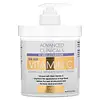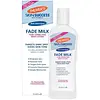What's inside
What's inside
 Key Ingredients
Key Ingredients

 Benefits
Benefits

 Concerns
Concerns

 Ingredients Side-by-side
Ingredients Side-by-side

Water
Skin ConditioningCetearyl Alcohol
EmollientParaffinum Liquidum
EmollientGlyceryl Stearate Se
EmulsifyingAloe Barbadensis Leaf Juice
Skin ConditioningCocos Nucifera Oil
MaskingIsopropyl Myristate
EmollientGlycerin
HumectantButylene Glycol
HumectantCeteareth-20
CleansingCaprylic/Capric Triglyceride
MaskingAminopropyl Ascorbyl Phosphate
AntioxidantTetrahexyldecyl Ascorbate
AntioxidantTocopheryl Acetate
AntioxidantCamellia Sinensis Leaf Extract
AntimicrobialDisodium EDTA
Ascorbic Acid
AntioxidantFerulic Acid
AntimicrobialParfum
MaskingAcrylates/C10-30 Alkyl Acrylate Crosspolymer
Emulsion StabilisingSodium Polyacrylate
AbsorbentEthylhexyl Stearate
EmollientTrideceth-6
EmulsifyingPhenoxyethanol
PreservativeCaprylyl Glycol
EmollientEthylhexylglycerin
Skin ConditioningHexylene Glycol
EmulsifyingSodium Hydroxide
BufferingWater, Cetearyl Alcohol, Paraffinum Liquidum, Glyceryl Stearate Se, Aloe Barbadensis Leaf Juice, Cocos Nucifera Oil, Isopropyl Myristate, Glycerin, Butylene Glycol, Ceteareth-20, Caprylic/Capric Triglyceride, Aminopropyl Ascorbyl Phosphate, Tetrahexyldecyl Ascorbate, Tocopheryl Acetate, Camellia Sinensis Leaf Extract, Disodium EDTA, Ascorbic Acid, Ferulic Acid, Parfum, Acrylates/C10-30 Alkyl Acrylate Crosspolymer, Sodium Polyacrylate, Ethylhexyl Stearate, Trideceth-6, Phenoxyethanol, Caprylyl Glycol, Ethylhexylglycerin, Hexylene Glycol, Sodium Hydroxide
Water
Skin ConditioningGlycerin
HumectantNiacinamide
SmoothingParaffinum Liquidum
EmollientCetearyl Alcohol
EmollientIsopropyl Myristate
EmollientEthylhexyl Dimethyl Paba
UV AbsorberStearyl Alcohol
EmollientDimethicone
EmollientGlyceryl Stearate
EmollientPEG-100 Stearate
Ceteareth-20
CleansingTocopheryl Acetate
AntioxidantRetinol
Skin ConditioningTricholoma Matsutake Extract
Skin ConditioningAscorbyl Palmitate
AntioxidantGlycyrrhiza Glabra Root Extract
BleachingLeuconostoc/Radish Root Ferment Filtrate
AntimicrobialCitric Acid
BufferingPhenoxyethanol
PreservativeButylene Glycol
HumectantPolysorbate 20
EmulsifyingHydroxypropyl Cyclodextrin
MaskingCaprylic/Capric Triglyceride
MaskingXanthan Gum
EmulsifyingLauryl Glucoside
CleansingEthylhexylglycerin
Skin ConditioningPropylene Glycol
HumectantDisodium EDTA
Parfum
MaskingCitronellol
PerfumingLimonene
PerfumingHydroxycitronellal
PerfumingButylphenyl Methylpropional
PerfumingLinalool
PerfumingHydroxyisohexyl 3-Cyclohexene Carboxaldehyde
MaskingAlpha-Isomethyl Ionone
PerfumingWater, Glycerin, Niacinamide, Paraffinum Liquidum, Cetearyl Alcohol, Isopropyl Myristate, Ethylhexyl Dimethyl Paba, Stearyl Alcohol, Dimethicone, Glyceryl Stearate, PEG-100 Stearate, Ceteareth-20, Tocopheryl Acetate, Retinol, Tricholoma Matsutake Extract, Ascorbyl Palmitate, Glycyrrhiza Glabra Root Extract, Leuconostoc/Radish Root Ferment Filtrate, Citric Acid, Phenoxyethanol, Butylene Glycol, Polysorbate 20, Hydroxypropyl Cyclodextrin, Caprylic/Capric Triglyceride, Xanthan Gum, Lauryl Glucoside, Ethylhexylglycerin, Propylene Glycol, Disodium EDTA, Parfum, Citronellol, Limonene, Hydroxycitronellal, Butylphenyl Methylpropional, Linalool, Hydroxyisohexyl 3-Cyclohexene Carboxaldehyde, Alpha-Isomethyl Ionone
 Reviews
Reviews

Ingredients Explained
These ingredients are found in both products.
Ingredients higher up in an ingredient list are typically present in a larger amount.
Butylene Glycol (or BG) is used within cosmetic products for a few different reasons:
Overall, Butylene Glycol is a safe and well-rounded ingredient that works well with other ingredients.
Though this ingredient works well with most skin types, some people with sensitive skin may experience a reaction such as allergic rashes, closed comedones, or itchiness.
Learn more about Butylene GlycolThis ingredient is an emollient, solvent, and texture enhancer. It is considered a skin-softener by helping the skin prevent moisture loss.
It helps thicken a product's formula and makes it easier to spread by dissolving clumping compounds.
Caprylic Triglyceride is made by combining glycerin with coconut oil, forming a clear liquid.
While there is an assumption Caprylic Triglyceride can clog pores due to it being derived from coconut oil, there is no research supporting this.
Learn more about Caprylic/Capric TriglycerideCeteareth-20 is an emulsifier and cleansing agent. It is derived from cetearyl alcohol, a fatty alcohol.
As an emulsifier, Ceteareth-20 prevents oil and water from separating. It is also a surfactant. Surfactants help gather oil, pollution, and dirt to be washed away.
Cetearyl alcohol is a mixture of two fatty alcohols: cetyl alcohol and stearyl alcohol. It is mainly used as an emulsifier. Emulsifiers help prevent the separation of oils and products. Due to its composition, it can also be used to thicken a product or help create foam.
Cetearyl alcohol is an emollient. Emollients help soothe and hydrate the skin by trapping moisture.
Studies show Cetearyl alcohol is non-toxic and non-irritating. The FDA allows products labeled "alcohol-free" to have fatty alcohols.
This ingredient is usually derived from plant oils such as palm, vegetable, or coconut oils. There is debate on whether this ingredient will cause acne.
Due to the fatty acid base, this ingredient may not be Malassezia folliculitis safe.
Learn more about Cetearyl AlcoholDisodium EDTA plays a role in making products more stable by aiding other preservatives.
It is a chelating agent, meaning it neutralizes metal ions that may be found in a product.
Disodium EDTA is a salt of edetic acid and is found to be safe in cosmetic ingredients.
Learn more about Disodium EDTAEthylhexylglycerin (we can't pronounce this either) is commonly used as a preservative and skin softener. It is derived from glyceryl.
You might see Ethylhexylglycerin often paired with other preservatives such as phenoxyethanol. Ethylhexylglycerin has been found to increase the effectiveness of these other preservatives.
Glycerin is already naturally found in your skin. It helps moisturize and protect your skin.
A study from 2016 found glycerin to be more effective as a humectant than AHAs and hyaluronic acid.
As a humectant, it helps the skin stay hydrated by pulling moisture to your skin. The low molecular weight of glycerin allows it to pull moisture into the deeper layers of your skin.
Hydrated skin improves your skin barrier; Your skin barrier helps protect against irritants and bacteria.
Glycerin has also been found to have antimicrobial and antiviral properties. Due to these properties, glycerin is often used in wound and burn treatments.
In cosmetics, glycerin is usually derived from plants such as soybean or palm. However, it can also be sourced from animals, such as tallow or animal fat.
This ingredient is organic, colorless, odorless, and non-toxic.
Glycerin is the name for this ingredient in American English. British English uses Glycerol/Glycerine.
Learn more about GlycerinIsopropyl Myristate is an emollient, thickening agent, and texture enhancer. It is created from isopropyl alcohol and myristic acid.
It is used to help other ingredients be better absorbed. It is also an emollient and may help soften and hydrate the skin.
The comedogenic rating of this ingredient depends on the concentration. Lower amounts results in a lower rating.
Isopropyl Myristate may not be fungal acne safe. It can potentially worsen acne prone skin.
Learn more about Isopropyl MyristateParaffinum Liquidum is also known as liquid paraffin. It is a type of highly refined mineral oil.
Like other oils, Paraffinum Liquidum has emollient properties. Emollients help soothe and soften the skin. By creating a barrier to trap moisture within, emollients help keep your skin hydrated.
Paraffinum Liquidum does not irritate the skin and is non-comedogenic.
Learn more about Paraffinum LiquidumParfum is a catch-all term for an ingredient or more that is used to give a scent to products.
Also called "fragrance", this ingredient can be a blend of hundreds of chemicals or plant oils. This means every product with "fragrance" or "parfum" in the ingredients list is a different mixture.
For instance, Habanolide is a proprietary trade name for a specific aroma chemical. When used as a fragrance ingredient in cosmetics, most aroma chemicals fall under the broad labeling category of “FRAGRANCE” or “PARFUM” according to EU and US regulations.
The term 'parfum' or 'fragrance' is not regulated in many countries. In many cases, it is up to the brand to define this term.
For instance, many brands choose to label themselves as "fragrance-free" because they are not using synthetic fragrances. However, their products may still contain ingredients such as essential oils that are considered a fragrance by INCI standards.
One example is Calendula flower extract. Calendula is an essential oil that still imparts a scent or 'fragrance'.
Depending on the blend, the ingredients in the mixture can cause allergies and sensitivities on the skin. Some ingredients that are known EU allergens include linalool and citronellol.
Parfum can also be used to mask or cover an unpleasant scent.
The bottom line is: not all fragrances/parfum/ingredients are created equally. If you are worried about fragrances, we recommend taking a closer look at an ingredient. And of course, we always recommend speaking with a professional.
Learn more about ParfumPhenoxyethanol is a preservative that has germicide, antimicrobial, and aromatic properties. Studies show that phenoxyethanol can prevent microbial growth. By itself, it has a scent that is similar to that of a rose.
It's often used in formulations along with Caprylyl Glycol to preserve the shelf life of products.
Tocopheryl Acetate is AKA Vitamin E. It is an antioxidant and protects your skin from free radicals. Free radicals damage the skin by breaking down collagen.
One study found using Tocopheryl Acetate with Vitamin C decreased the number of sunburned cells.
Tocopheryl Acetate is commonly found in both skincare and dietary supplements.
Learn more about Tocopheryl AcetateWater. It's the most common cosmetic ingredient of all. You'll usually see it at the top of ingredient lists, meaning that it makes up the largest part of the product.
So why is it so popular? Water most often acts as a solvent - this means that it helps dissolve other ingredients into the formulation.
You'll also recognize water as that liquid we all need to stay alive. If you see this, drink a glass of water. Stay hydrated!
Learn more about Water